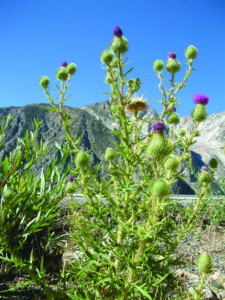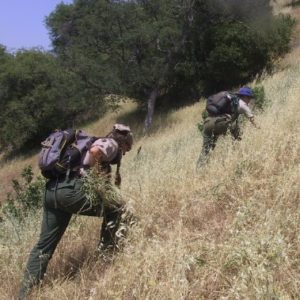
Some invasive plants, like bull thistle, are reaching higher elevations in a warming climate. Photo by Bob Case
Climate change is a major challenge for natural resource managers, and interactions with invasive plants are a big part of the challenge. Some invasive plants may be able to expand into new areas, such as higher elevations, thanks to a warming climate. In other areas, climate change may provide opportunities for controlling invasive plants that do not tolerate new conditions well. While native flora and fauna adapt to new environmental conditions, managers will adapt their management to focus limited resources most effectively. The fundamental questions for invasive plant control remain the same – which species are the most important to control in each area? – but the complexities of a rapidly changing climate require more sophisticated answers. Serving as a link between researchers and practitioners in the natural resource community, Cal-IPC is helping managers develop new and better ways to address strategic challenges related to climate change.
Cal-IPC Resources
Resilience guidelines – Two short reports describing how removing invasive plants can help climate change resilience in mountain meadows, suggesting actions for land managers. December 2015.
- Impacts of Climate Change and Invasive Plants in Sierra Meadows: Overview and Recommendations
- Incorporating Climate Resilience into Invasive Plant Management Projects: Guidance for Land Managers
Workshop Presentations – Presentations from our workshop on Climate Smart Land Management, October 2013.
- Uncertainty: Making land management decisions in a time of rapid change – Virginia Matzek, Santa Clara University
- Principles: Guidelines from leading organizations – Sandy DeSimone, Audubon Starr Ranch
- What to do when you don’t know what to expect: Scenario planning for land management – Nathaniel Seavy, Point Blue Conservation Science
- Making ecological restoration climate-smart: a framework and lessons learned –Nathaniel Seavy, Point Blue Conservation Science
Climate Adaptation Exercise – At the workshop, participants used this exercise to conduct a hypothetical climate adaptation plan for invasive plants at Audubon Starr Ranch in Orange County. The matrix and instructions below are a first attempt at developing a methodology for this type of plan.
Climate suitability maps – Our CalWeedMapper website contains maps of projected suitable range for invasive plants, based on ecological niche modeling. Knowing where suitable range is expanding or shrinking is useful in planning management efforts geared toward helping native habitats adapt to climate change. Go to the Advanced page and select Legend/Choose Layers to turn on model results.
Watchlist and Invasive Plant Alerts – Cal-IPC’s Watchlist lists plants that are starting to spread and cause concern, but that are not yet on our Invasive Plant Inventory. The annual Invasive Plant Alerts presentation at our Symposium includes information on new invasive plants and range expansions.These species may spread in the future due to climatic changes and should be considered potential targets for early detection and rapid response.
Other Resources

Invasive plant management needs to adapt to climate change. Photo by Bobbi Simpson, NPS
Bioinvasions in a Changing World: A Resource on Invasive Species-Climate Change Interactions for Conservation and Natural Resource Management (2014) – Cal-IPC assisted with this report that provides an overview of the connections between invasive species and climate change then looks at ways to approach conservation and natural resource management in the face of climate change.
California Climate Commons – Guidance materials for climate-smart conservation
Cal-Adapt – From the California Department of Natural Resources
CAKE – Climate Adaptation Knowledge Exchange portal
National Wildlife Federation – Climate change adaptation guides and a review of climate adaptation literature
Point Blue Conservation Science – Climate-smart conservation resources from Point Blue (formerly PRBO). Download their report on “Projected Effects of Climate Change in California: Ecoregional Summaries Emphasizing Consequences for Wildlife”
INHABIT – The USGS tool shows modeled ranges of invasive plants across the US.
US Forest Service’s TACCIMO – Web tool from the US Forest Service. Allows a user to search for and generate reports on climate change literature on particular topics and summaries of projected changes. Climate change reports can be generated at the scale of a county. Short training videos explain how to use the features.
The Climate-Smart Land Management workshop was made possible by funding from the California Landscape Conservation Cooperative. For more information, please contact us.
